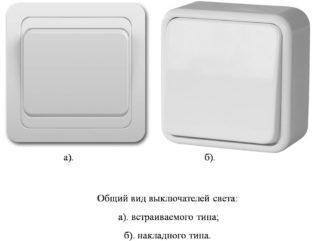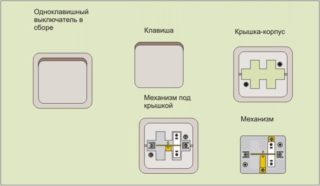In domestic conditions, situations are not uncommon when, during the next repair of electrical wiring, it becomes possible to replace the switches installed in the lighting network. Usually this operation is combined with updating the brand of switching devices or replacing aged and worn samples. Installing a one-key switch with your own hands is not at all difficult. To do this, you will need to familiarize yourself with the features of its design and all the intricacies of installing an external or built-in electrical device.
Selecting the desired sample
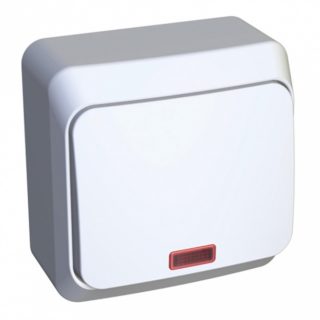
After deciding on an independent replacement of the switching mechanism, first of all, you should decide on a suitable sample for this. When looking for a reliable outlet, contact only those stores that specialize in the sale of branded electrical products. Only if this rule is observed, it is possible to select a high-quality device for controlling room lighting.
In addition, the purchased external one-key switch must comply with the requirements of GOST R 51324.1 of 1999:
- is selected only after evaluating the main operational and technical characteristics, such as switching method, operating voltage and maximum permissible current;
- each model must have a quality certificate issued by a specific manufacturer;
- the product should not disturb the general interior of the room.
Models produced by most manufacturers are designed mainly for load currents up to 10-16 Amperes and a voltage of 250 Volts.
In practice, there are exceptions to generally accepted standards. Samples with sintered contacts with silver additives are current limited to 4 Amperes. In addition to the parameters that determine the current mode of operation, when choosing switching devices, the number of available poles is taken into account (it can vary from one to 3). One of these varieties is a two-pole one-key switch.
When buying, also evaluate the quality and reliability of the assembly of the product and check it for operability. You should not purchase samples with traces of clearly distinguishable defects and with a constantly sticking key.
Varieties of switching devices
- switching method;
- installation option (hidden or outdoor installation);
- the degree of protection against climatic influences.
In addition, they differ in brand as well as cost and design. When choosing a switching product you like, these signs are taken into account in a comprehensive manner at the discretion of the user.
According to the switching method, the known samples of switches are divided into the following types:
- crossover models;
- devices with a rotary switching mechanism;
- devices equipped with a conventional button.
According to the method of installation, the products are manufactured in two modifications intended for open or hidden electrical wiring. According to the degree of protection, they are subdivided into samples having a conventional design and models in a moisture and dustproof design. The latter type is reliably protected from climatic and mechanical influences and can be operated in conditions of high humidity and heavy dust.
There are models presented in a "modular" design, which presupposes the presence of an outlet combined with a switch. This type of switching devices is used in situations where in the bathroom or bedroom next to the switch it is required to have a socket for connecting an electric hair dryer, for example.
Installation and connection procedure
- when installing a switching device, the type of wiring must be taken into account;
- a switch for open wiring, for example, is mounted directly on a wall surface, if it is sufficiently rigid and reliable;
- another option allows mounting on a special wooden lining, called a socket box;
- one-key switches for hidden wiring will need to be sunk into the wall, having previously selected a socket of the appropriate diameter in it.
Concealed mounting requires an electric drill and a special attachment, colloquially called a "crown".
First, a plastic box is recessed into the prepared niche, which is used to fix the case. Experts advise to securely fix it in the thickness of the wall, having missed the edges with pre-diluted construction alabaster. Only after fixing the plastic cup, the internal single-key switch itself is placed in it, after which it will remain to fix it with the hardware supplied with the kit.
Disconnection options
Difficulties with connecting a device installed in one way or another, as a rule, do not arise. According to the general wiring diagram, a phase wire is connected to its lower terminal from a linear machine that protects this branch of the wiring from overloads. Questions arise only when choosing a method of switching the conductors leading to the chandelier. In this case, the following connection options are possible:
- using a junction box;
- connecting the installed device directly to the chandelier.
Any of these approaches has its own advantages and disadvantages and is selected based on the real conditions of mounting a single-keyboard player.
Through the junction box

If there is a junction box already mounted in the wall, the order of switching is as follows:
- There is a box placed directly above the room outlet near the ceiling. Its lid, with the internal laying method, can be hidden under wallpaper or whitewash.
- Open it and find free contacts inside.
- Disconnect (connect) the phase wire coming from the upper terminal of the switch with the bus extended from the chandelier or LED backlight designed for 220 volts.
In any case, it is better to make this section of the wiring open, since it will take too much time to find out which of the hidden conductors will reach the desired lighting fixture. It is easier to "throw" a new core over the top, then hiding it in the cable channel.
The advantage of the method using a junction box is the simplicity of changing the cross-connection of wires and the ability to connect another light source to the mounted device. The disadvantage is the presence of additional contacts, which in electrical engineering always mean a decrease in the reliability of the connecting line.
Direct connection
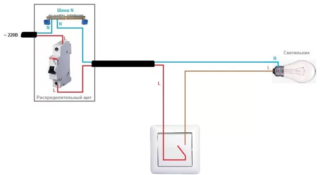
With a direct connection to the chandelier, the phase wire, laid openly and at a right angle, will have to be connected directly to the top terminal of the switch, and then placed in the cable channel.
An earthen vein in most old buildings is supplied to the illuminator along the internal cavities of the ceiling. It is often led out through a hole in the ceiling in the form of an aluminum wire with white insulation.When connecting the chandelier, you should use special transition terminal blocks, which allow you to establish a contactless connection of copper and aluminum conductors.
With a hidden laying, the matter is complicated by the fact that you first need to find the phase wire in the twist placed in the grooves and only then connect it to the lower terminal of the switch. It is good if it, like the conductors in the junction box, is color-coded (blue - ground, red or brown - phase).
Installing a new wiring box
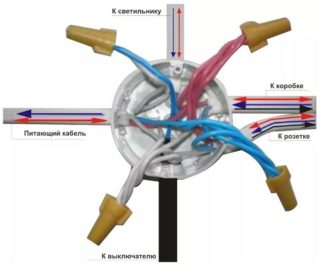
If a decision is made to route the wires through the junction box, and it is not possible to find its cover anywhere, you will have to engage in self-installation of a new product. To do this, you need to perform a number of simple operations performed in the following sequence:
- Purchase a junction box from a store that is suitable for surface (outdoor) mounting.
- Choose a place above the switch, which is closer to the ceiling, and fix the purchased product on it, opening the cover first.
- Select a pair of contacts inside and connect to one of them the phase wire taken from the switch, and connect the bus to the second from the chandelier or LED backlight.
- Then you will need to install a jumper between these two pins.
- At the end of the work, it remains only to replace the cover of the junction box.
When carrying out any installation operations related to the wiring of electrical circuits and devices, it is important to comply with the requirements of the PUE regarding safety.
Compliance with safety requirements
- before starting work in the wiring line, it is imperative to turn off the input circuit breaker or protection device serving this branch from it;
- before touching the bare ends of the working conductors, you must once again make sure that there is no phase voltage on them, for this you should use the simplest tool - an indicator screwdriver, the presence of a dangerous potential is determined by the glow of the light bulb;
- when handling an electric drill, you must be very careful and try not to damage the electrical wiring laid in the wall;
- when working with an already installed junction box, regardless of whether the local machine is turned off or not, you need to make sure once again that there is no voltage of 220 volts at its contacts, since the box can be connected to another linear machine.
Before installing a new junction box, you should determine the exact place under which hidden electrical wiring is not laid in the depths of the walls. In this case, they proceed from the requirements provided for by the PUE, according to which any taps from it are made only at right angles. Therefore, the line of possible laying of wires from the outlet can only run strictly vertically up or down (the latter option is extremely rare).
Installation and connection of a one-button switch is quite within the power of even a layman who owns the simplest techniques of working with a screwdriver.

